Research Proposal: Promoting Hand Hygiene in Healthcare Settings
VerifiedAdded on 2023/01/07
|23
|6832
|22
Report
AI Summary
This research proposal focuses on identifying effective strategies to promote hand hygiene within healthcare settings. The introduction establishes the research aim and objectives, emphasizing the importance of hand hygiene in preventing infections, especially in light of situations like COVID-19. A literature review synthesizes existing research on hand hygiene's significance, factors influencing compliance, and various promotion methods. The research methodology outlines a descriptive design, utilizing a positivism research philosophy, a deductive approach, and quantitative research methods, including questionnaires, to collect data. Data analysis will involve frequency distribution analysis and MS-Excel for graphical representations. The proposal concludes with recommendations for promoting hand hygiene, aiming to improve patient safety and reduce the spread of infections within healthcare environments. The proposal also includes a table of contents, references, and an abstract summarizing the research's purpose and scope.
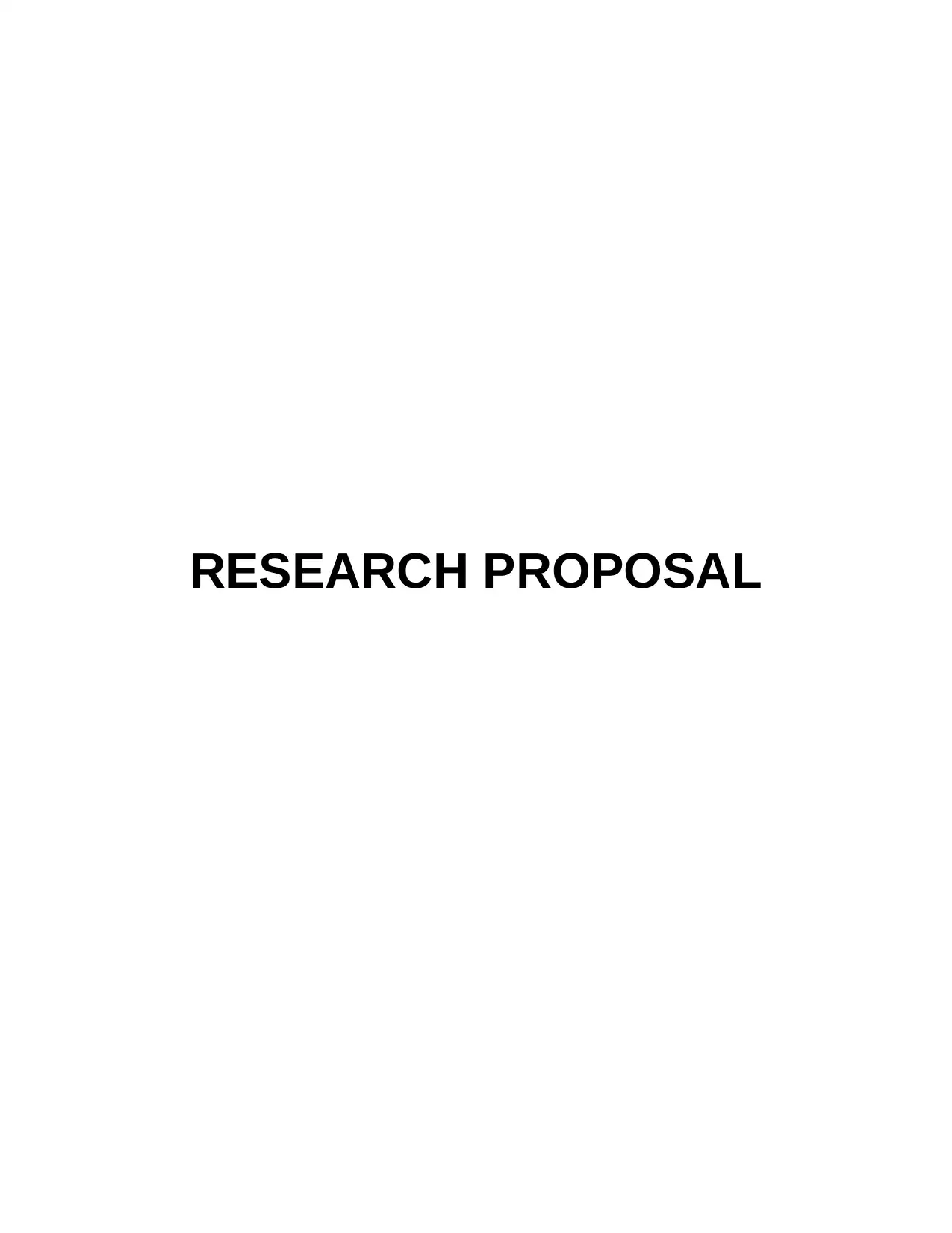
RESEARCH PROPOSAL
Paraphrase This Document
Need a fresh take? Get an instant paraphrase of this document with our AI Paraphraser
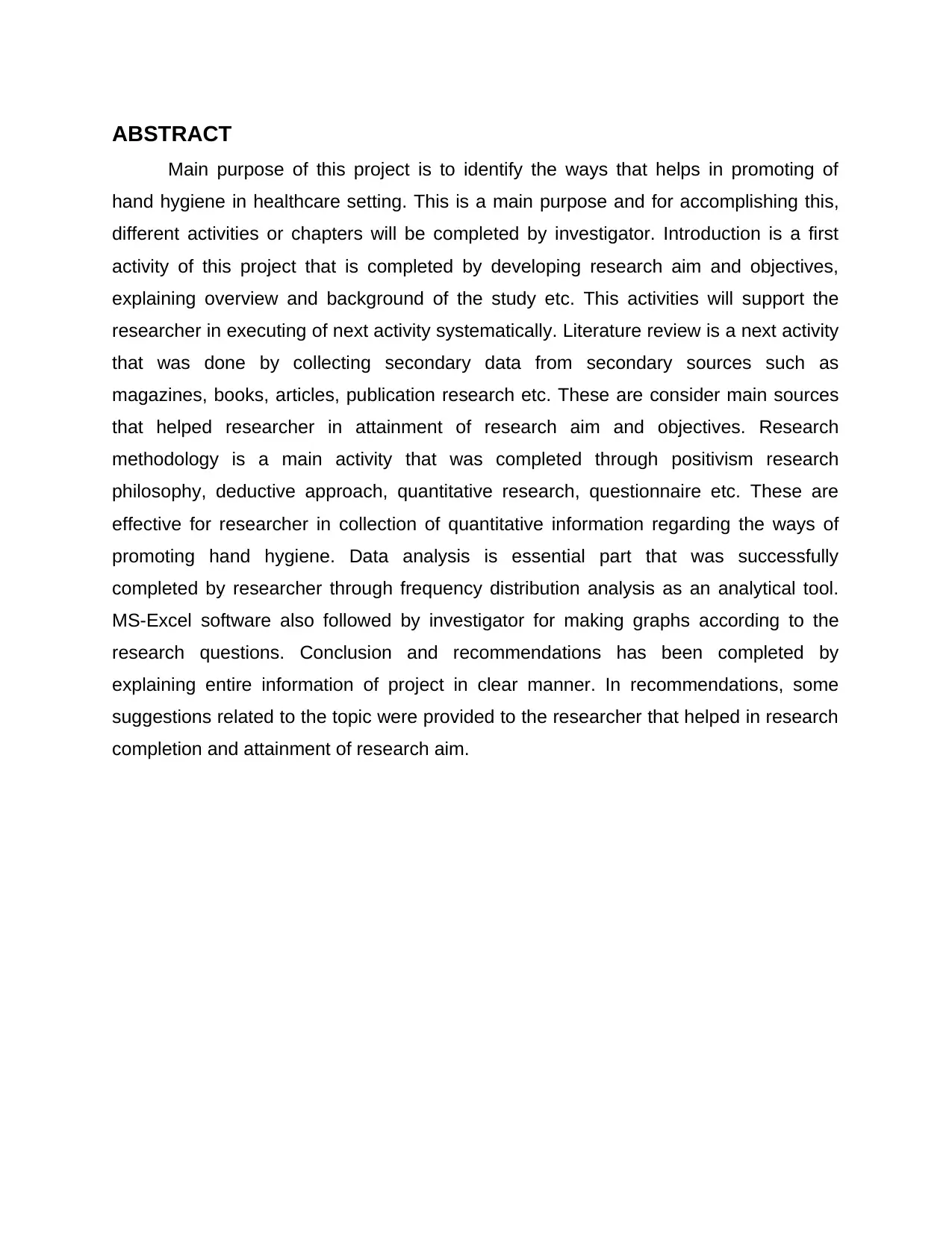
ABSTRACT
Main purpose of this project is to identify the ways that helps in promoting of
hand hygiene in healthcare setting. This is a main purpose and for accomplishing this,
different activities or chapters will be completed by investigator. Introduction is a first
activity of this project that is completed by developing research aim and objectives,
explaining overview and background of the study etc. This activities will support the
researcher in executing of next activity systematically. Literature review is a next activity
that was done by collecting secondary data from secondary sources such as
magazines, books, articles, publication research etc. These are consider main sources
that helped researcher in attainment of research aim and objectives. Research
methodology is a main activity that was completed through positivism research
philosophy, deductive approach, quantitative research, questionnaire etc. These are
effective for researcher in collection of quantitative information regarding the ways of
promoting hand hygiene. Data analysis is essential part that was successfully
completed by researcher through frequency distribution analysis as an analytical tool.
MS-Excel software also followed by investigator for making graphs according to the
research questions. Conclusion and recommendations has been completed by
explaining entire information of project in clear manner. In recommendations, some
suggestions related to the topic were provided to the researcher that helped in research
completion and attainment of research aim.
Main purpose of this project is to identify the ways that helps in promoting of
hand hygiene in healthcare setting. This is a main purpose and for accomplishing this,
different activities or chapters will be completed by investigator. Introduction is a first
activity of this project that is completed by developing research aim and objectives,
explaining overview and background of the study etc. This activities will support the
researcher in executing of next activity systematically. Literature review is a next activity
that was done by collecting secondary data from secondary sources such as
magazines, books, articles, publication research etc. These are consider main sources
that helped researcher in attainment of research aim and objectives. Research
methodology is a main activity that was completed through positivism research
philosophy, deductive approach, quantitative research, questionnaire etc. These are
effective for researcher in collection of quantitative information regarding the ways of
promoting hand hygiene. Data analysis is essential part that was successfully
completed by researcher through frequency distribution analysis as an analytical tool.
MS-Excel software also followed by investigator for making graphs according to the
research questions. Conclusion and recommendations has been completed by
explaining entire information of project in clear manner. In recommendations, some
suggestions related to the topic were provided to the researcher that helped in research
completion and attainment of research aim.
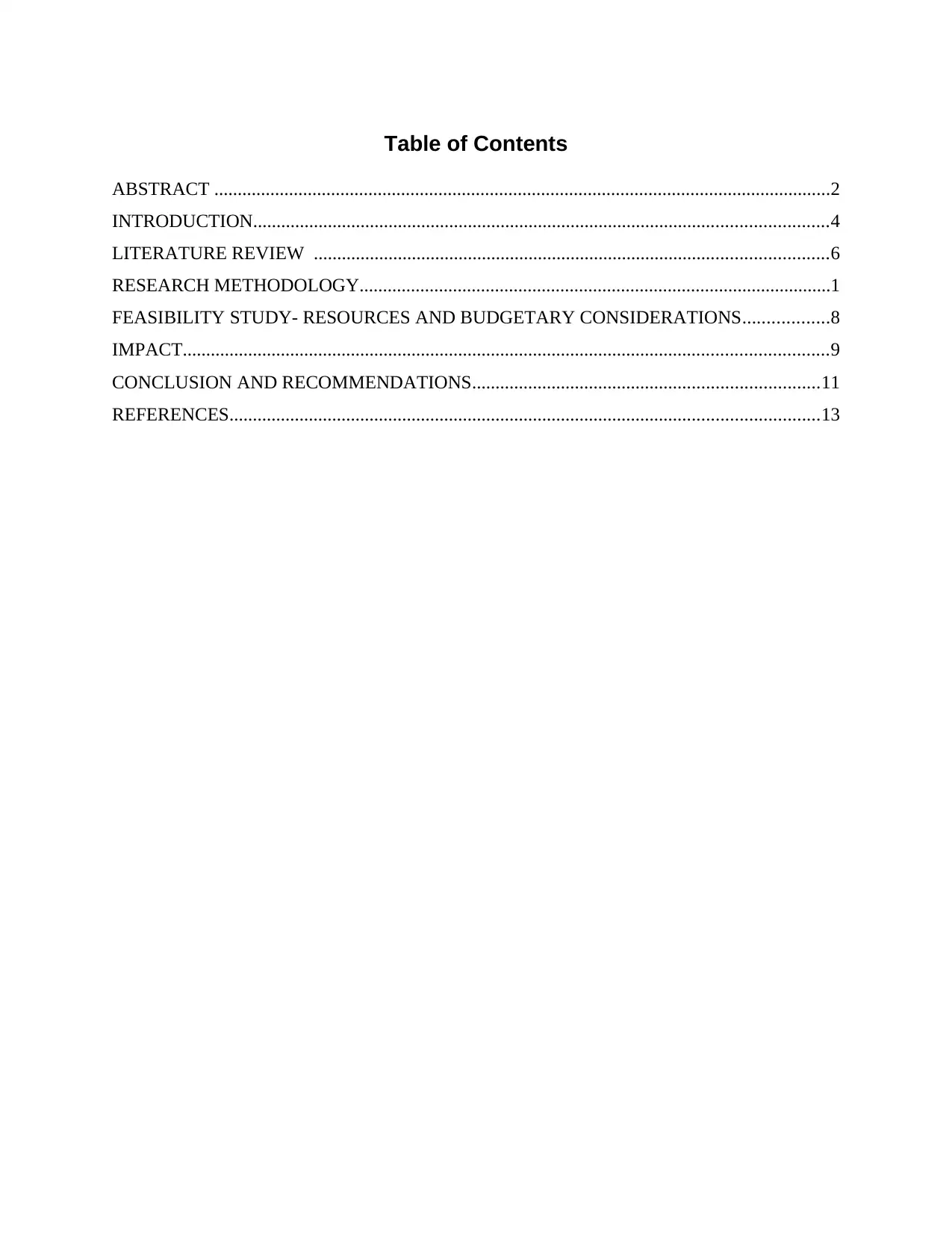
Table of Contents
ABSTRACT ....................................................................................................................................2
INTRODUCTION...........................................................................................................................4
LITERATURE REVIEW ..............................................................................................................6
RESEARCH METHODOLOGY.....................................................................................................1
FEASIBILITY STUDY- RESOURCES AND BUDGETARY CONSIDERATIONS..................8
IMPACT..........................................................................................................................................9
CONCLUSION AND RECOMMENDATIONS..........................................................................11
REFERENCES..............................................................................................................................13
ABSTRACT ....................................................................................................................................2
INTRODUCTION...........................................................................................................................4
LITERATURE REVIEW ..............................................................................................................6
RESEARCH METHODOLOGY.....................................................................................................1
FEASIBILITY STUDY- RESOURCES AND BUDGETARY CONSIDERATIONS..................8
IMPACT..........................................................................................................................................9
CONCLUSION AND RECOMMENDATIONS..........................................................................11
REFERENCES..............................................................................................................................13
⊘ This is a preview!⊘
Do you want full access?
Subscribe today to unlock all pages.

Trusted by 1+ million students worldwide
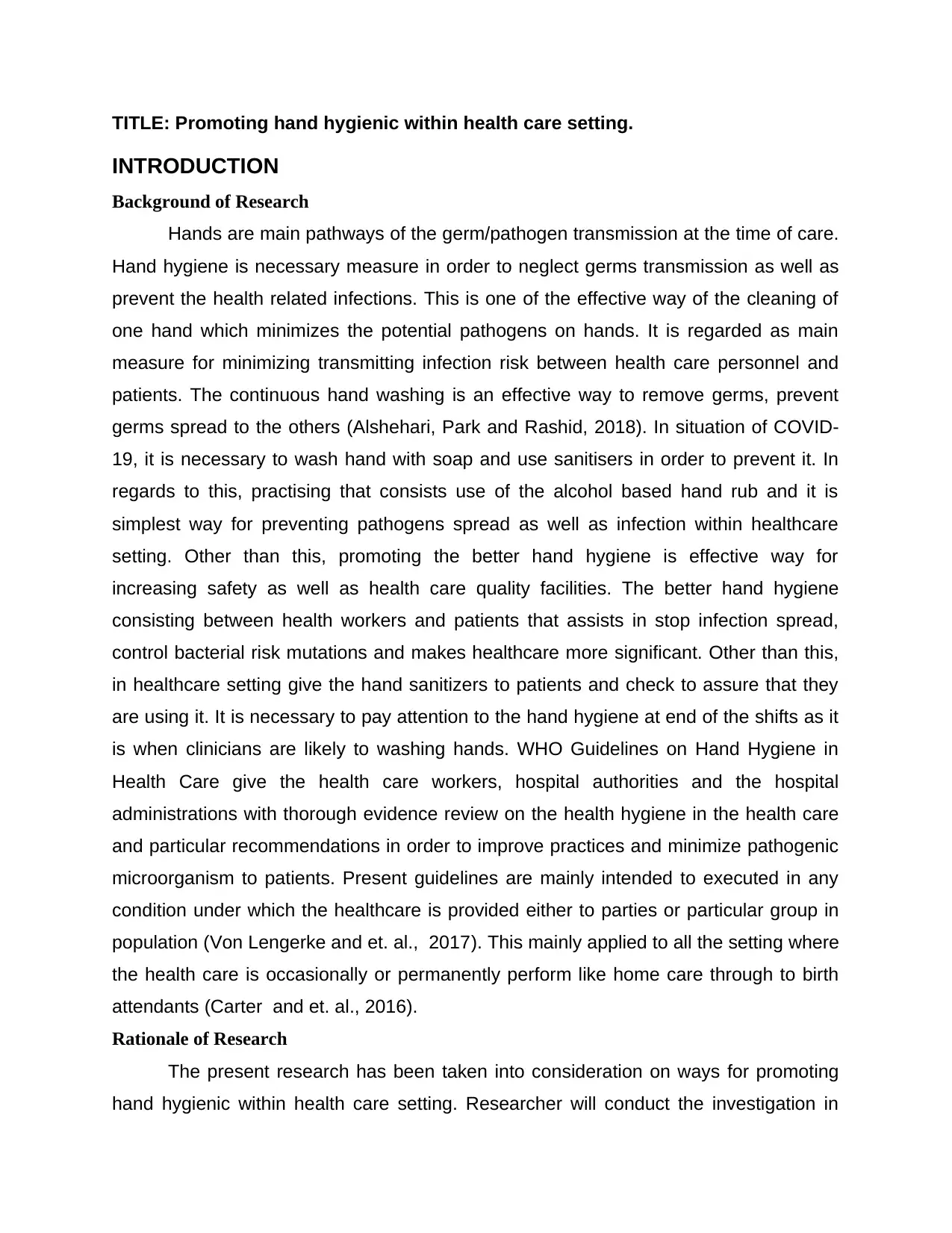
TITLE: Promoting hand hygienic within health care setting.
INTRODUCTION
Background of Research
Hands are main pathways of the germ/pathogen transmission at the time of care.
Hand hygiene is necessary measure in order to neglect germs transmission as well as
prevent the health related infections. This is one of the effective way of the cleaning of
one hand which minimizes the potential pathogens on hands. It is regarded as main
measure for minimizing transmitting infection risk between health care personnel and
patients. The continuous hand washing is an effective way to remove germs, prevent
germs spread to the others (Alshehari, Park and Rashid, 2018). In situation of COVID-
19, it is necessary to wash hand with soap and use sanitisers in order to prevent it. In
regards to this, practising that consists use of the alcohol based hand rub and it is
simplest way for preventing pathogens spread as well as infection within healthcare
setting. Other than this, promoting the better hand hygiene is effective way for
increasing safety as well as health care quality facilities. The better hand hygiene
consisting between health workers and patients that assists in stop infection spread,
control bacterial risk mutations and makes healthcare more significant. Other than this,
in healthcare setting give the hand sanitizers to patients and check to assure that they
are using it. It is necessary to pay attention to the hand hygiene at end of the shifts as it
is when clinicians are likely to washing hands. WHO Guidelines on Hand Hygiene in
Health Care give the health care workers, hospital authorities and the hospital
administrations with thorough evidence review on the health hygiene in the health care
and particular recommendations in order to improve practices and minimize pathogenic
microorganism to patients. Present guidelines are mainly intended to executed in any
condition under which the healthcare is provided either to parties or particular group in
population (Von Lengerke and et. al., 2017). This mainly applied to all the setting where
the health care is occasionally or permanently perform like home care through to birth
attendants (Carter and et. al., 2016).
Rationale of Research
The present research has been taken into consideration on ways for promoting
hand hygienic within health care setting. Researcher will conduct the investigation in
INTRODUCTION
Background of Research
Hands are main pathways of the germ/pathogen transmission at the time of care.
Hand hygiene is necessary measure in order to neglect germs transmission as well as
prevent the health related infections. This is one of the effective way of the cleaning of
one hand which minimizes the potential pathogens on hands. It is regarded as main
measure for minimizing transmitting infection risk between health care personnel and
patients. The continuous hand washing is an effective way to remove germs, prevent
germs spread to the others (Alshehari, Park and Rashid, 2018). In situation of COVID-
19, it is necessary to wash hand with soap and use sanitisers in order to prevent it. In
regards to this, practising that consists use of the alcohol based hand rub and it is
simplest way for preventing pathogens spread as well as infection within healthcare
setting. Other than this, promoting the better hand hygiene is effective way for
increasing safety as well as health care quality facilities. The better hand hygiene
consisting between health workers and patients that assists in stop infection spread,
control bacterial risk mutations and makes healthcare more significant. Other than this,
in healthcare setting give the hand sanitizers to patients and check to assure that they
are using it. It is necessary to pay attention to the hand hygiene at end of the shifts as it
is when clinicians are likely to washing hands. WHO Guidelines on Hand Hygiene in
Health Care give the health care workers, hospital authorities and the hospital
administrations with thorough evidence review on the health hygiene in the health care
and particular recommendations in order to improve practices and minimize pathogenic
microorganism to patients. Present guidelines are mainly intended to executed in any
condition under which the healthcare is provided either to parties or particular group in
population (Von Lengerke and et. al., 2017). This mainly applied to all the setting where
the health care is occasionally or permanently perform like home care through to birth
attendants (Carter and et. al., 2016).
Rationale of Research
The present research has been taken into consideration on ways for promoting
hand hygienic within health care setting. Researcher will conduct the investigation in
Paraphrase This Document
Need a fresh take? Get an instant paraphrase of this document with our AI Paraphraser
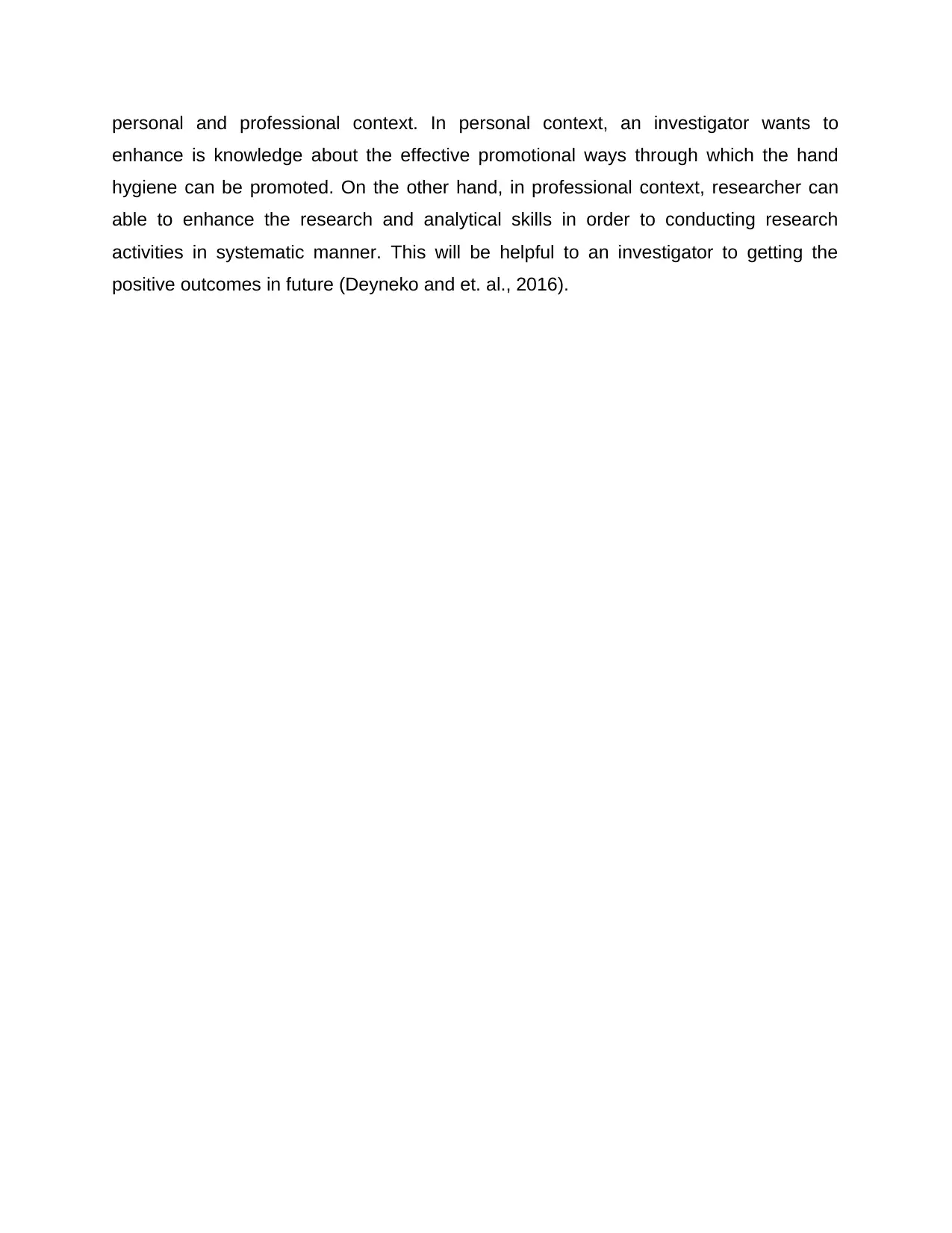
personal and professional context. In personal context, an investigator wants to
enhance is knowledge about the effective promotional ways through which the hand
hygiene can be promoted. On the other hand, in professional context, researcher can
able to enhance the research and analytical skills in order to conducting research
activities in systematic manner. This will be helpful to an investigator to getting the
positive outcomes in future (Deyneko and et. al., 2016).
enhance is knowledge about the effective promotional ways through which the hand
hygiene can be promoted. On the other hand, in professional context, researcher can
able to enhance the research and analytical skills in order to conducting research
activities in systematic manner. This will be helpful to an investigator to getting the
positive outcomes in future (Deyneko and et. al., 2016).
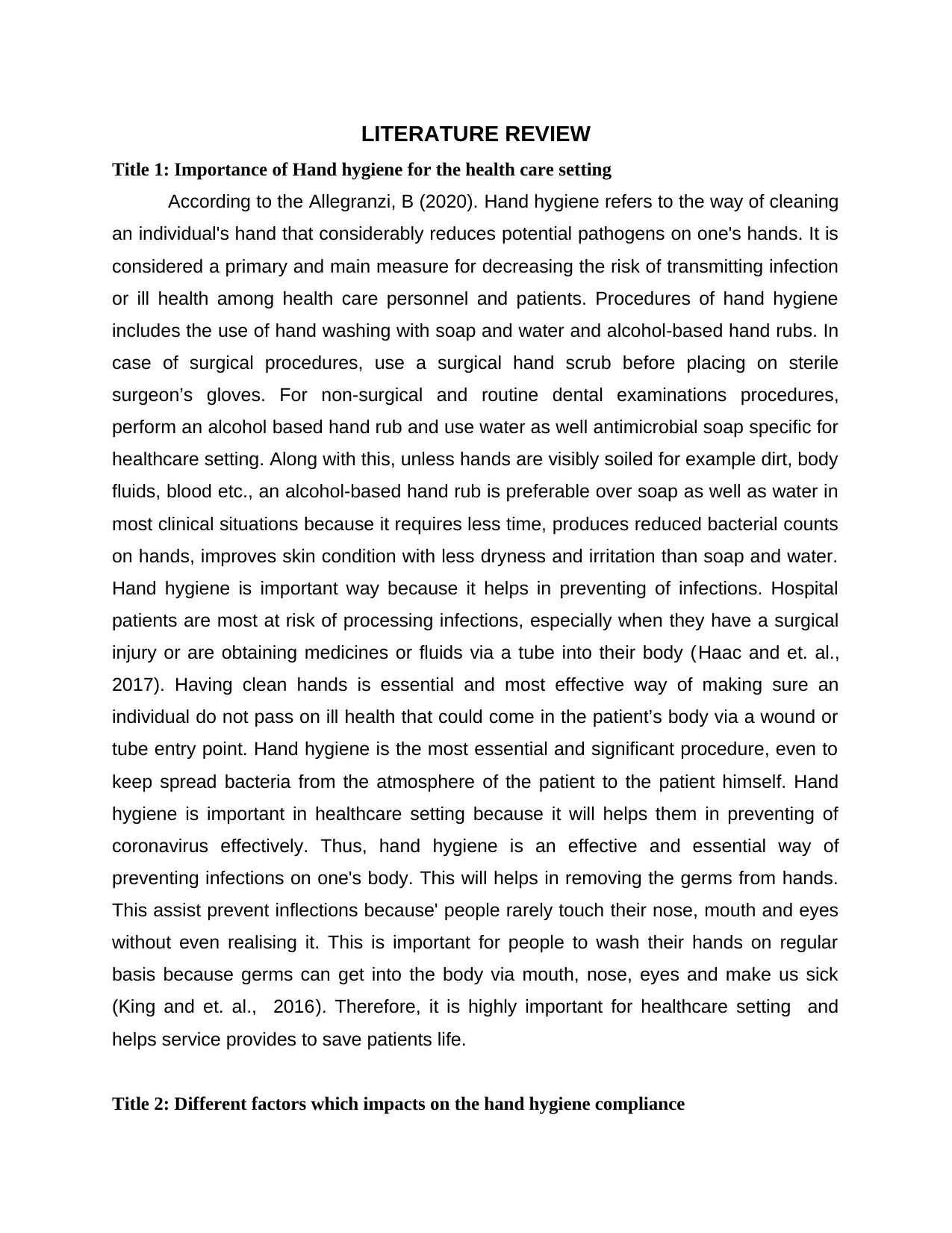
LITERATURE REVIEW
Title 1: Importance of Hand hygiene for the health care setting
According to the Allegranzi, B (2020). Hand hygiene refers to the way of cleaning
an individual's hand that considerably reduces potential pathogens on one's hands. It is
considered a primary and main measure for decreasing the risk of transmitting infection
or ill health among health care personnel and patients. Procedures of hand hygiene
includes the use of hand washing with soap and water and alcohol-based hand rubs. In
case of surgical procedures, use a surgical hand scrub before placing on sterile
surgeon’s gloves. For non-surgical and routine dental examinations procedures,
perform an alcohol based hand rub and use water as well antimicrobial soap specific for
healthcare setting. Along with this, unless hands are visibly soiled for example dirt, body
fluids, blood etc., an alcohol-based hand rub is preferable over soap as well as water in
most clinical situations because it requires less time, produces reduced bacterial counts
on hands, improves skin condition with less dryness and irritation than soap and water.
Hand hygiene is important way because it helps in preventing of infections. Hospital
patients are most at risk of processing infections, especially when they have a surgical
injury or are obtaining medicines or fluids via a tube into their body (Haac and et. al.,
2017). Having clean hands is essential and most effective way of making sure an
individual do not pass on ill health that could come in the patient’s body via a wound or
tube entry point. Hand hygiene is the most essential and significant procedure, even to
keep spread bacteria from the atmosphere of the patient to the patient himself. Hand
hygiene is important in healthcare setting because it will helps them in preventing of
coronavirus effectively. Thus, hand hygiene is an effective and essential way of
preventing infections on one's body. This will helps in removing the germs from hands.
This assist prevent inflections because' people rarely touch their nose, mouth and eyes
without even realising it. This is important for people to wash their hands on regular
basis because germs can get into the body via mouth, nose, eyes and make us sick
(King and et. al., 2016). Therefore, it is highly important for healthcare setting and
helps service provides to save patients life.
Title 2: Different factors which impacts on the hand hygiene compliance
Title 1: Importance of Hand hygiene for the health care setting
According to the Allegranzi, B (2020). Hand hygiene refers to the way of cleaning
an individual's hand that considerably reduces potential pathogens on one's hands. It is
considered a primary and main measure for decreasing the risk of transmitting infection
or ill health among health care personnel and patients. Procedures of hand hygiene
includes the use of hand washing with soap and water and alcohol-based hand rubs. In
case of surgical procedures, use a surgical hand scrub before placing on sterile
surgeon’s gloves. For non-surgical and routine dental examinations procedures,
perform an alcohol based hand rub and use water as well antimicrobial soap specific for
healthcare setting. Along with this, unless hands are visibly soiled for example dirt, body
fluids, blood etc., an alcohol-based hand rub is preferable over soap as well as water in
most clinical situations because it requires less time, produces reduced bacterial counts
on hands, improves skin condition with less dryness and irritation than soap and water.
Hand hygiene is important way because it helps in preventing of infections. Hospital
patients are most at risk of processing infections, especially when they have a surgical
injury or are obtaining medicines or fluids via a tube into their body (Haac and et. al.,
2017). Having clean hands is essential and most effective way of making sure an
individual do not pass on ill health that could come in the patient’s body via a wound or
tube entry point. Hand hygiene is the most essential and significant procedure, even to
keep spread bacteria from the atmosphere of the patient to the patient himself. Hand
hygiene is important in healthcare setting because it will helps them in preventing of
coronavirus effectively. Thus, hand hygiene is an effective and essential way of
preventing infections on one's body. This will helps in removing the germs from hands.
This assist prevent inflections because' people rarely touch their nose, mouth and eyes
without even realising it. This is important for people to wash their hands on regular
basis because germs can get into the body via mouth, nose, eyes and make us sick
(King and et. al., 2016). Therefore, it is highly important for healthcare setting and
helps service provides to save patients life.
Title 2: Different factors which impacts on the hand hygiene compliance
⊘ This is a preview!⊘
Do you want full access?
Subscribe today to unlock all pages.

Trusted by 1+ million students worldwide
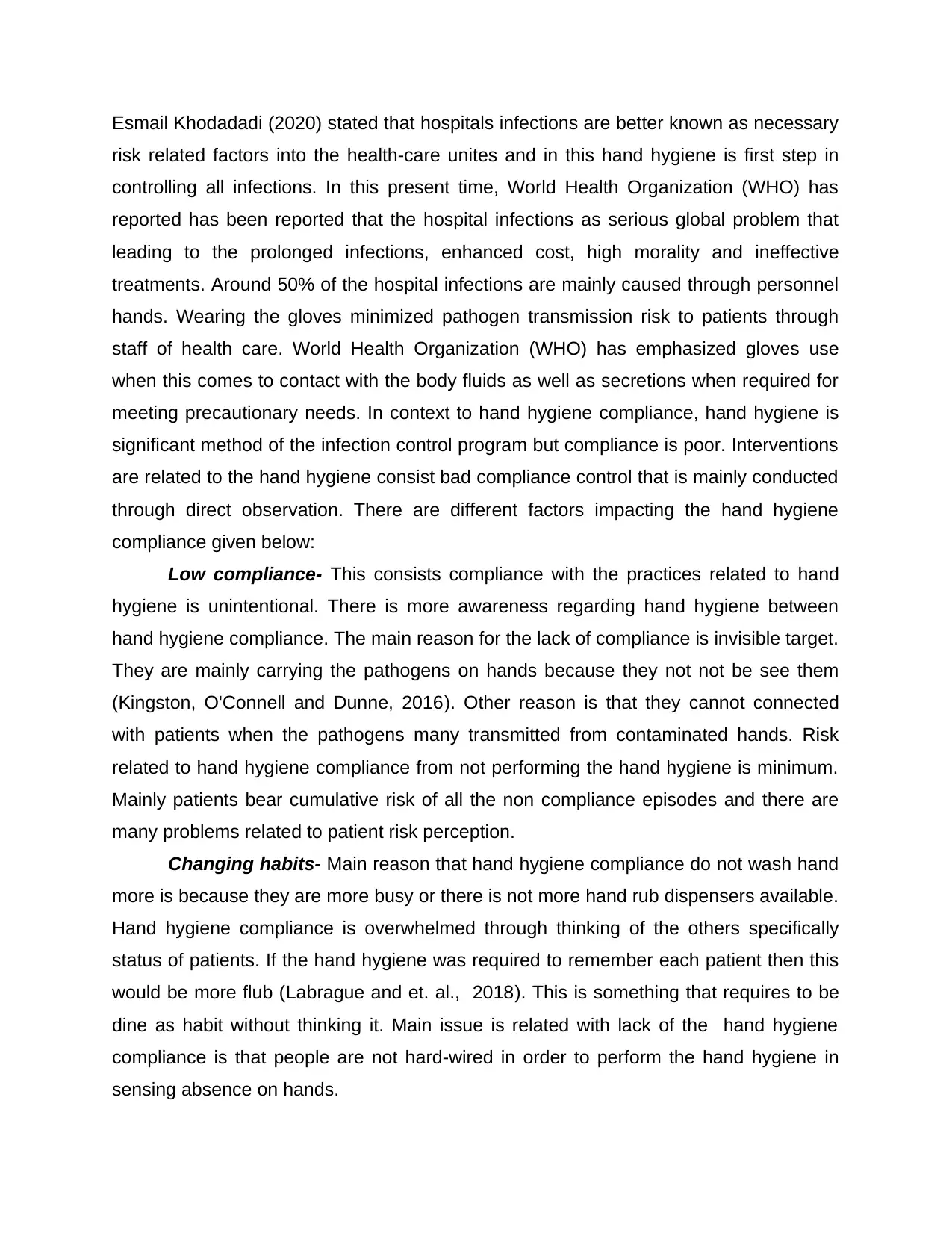
Esmail Khodadadi (2020) stated that hospitals infections are better known as necessary
risk related factors into the health-care unites and in this hand hygiene is first step in
controlling all infections. In this present time, World Health Organization (WHO) has
reported has been reported that the hospital infections as serious global problem that
leading to the prolonged infections, enhanced cost, high morality and ineffective
treatments. Around 50% of the hospital infections are mainly caused through personnel
hands. Wearing the gloves minimized pathogen transmission risk to patients through
staff of health care. World Health Organization (WHO) has emphasized gloves use
when this comes to contact with the body fluids as well as secretions when required for
meeting precautionary needs. In context to hand hygiene compliance, hand hygiene is
significant method of the infection control program but compliance is poor. Interventions
are related to the hand hygiene consist bad compliance control that is mainly conducted
through direct observation. There are different factors impacting the hand hygiene
compliance given below:
Low compliance- This consists compliance with the practices related to hand
hygiene is unintentional. There is more awareness regarding hand hygiene between
hand hygiene compliance. The main reason for the lack of compliance is invisible target.
They are mainly carrying the pathogens on hands because they not not be see them
(Kingston, O'Connell and Dunne, 2016). Other reason is that they cannot connected
with patients when the pathogens many transmitted from contaminated hands. Risk
related to hand hygiene compliance from not performing the hand hygiene is minimum.
Mainly patients bear cumulative risk of all the non compliance episodes and there are
many problems related to patient risk perception.
Changing habits- Main reason that hand hygiene compliance do not wash hand
more is because they are more busy or there is not more hand rub dispensers available.
Hand hygiene compliance is overwhelmed through thinking of the others specifically
status of patients. If the hand hygiene was required to remember each patient then this
would be more flub (Labrague and et. al., 2018). This is something that requires to be
dine as habit without thinking it. Main issue is related with lack of the hand hygiene
compliance is that people are not hard-wired in order to perform the hand hygiene in
sensing absence on hands.
risk related factors into the health-care unites and in this hand hygiene is first step in
controlling all infections. In this present time, World Health Organization (WHO) has
reported has been reported that the hospital infections as serious global problem that
leading to the prolonged infections, enhanced cost, high morality and ineffective
treatments. Around 50% of the hospital infections are mainly caused through personnel
hands. Wearing the gloves minimized pathogen transmission risk to patients through
staff of health care. World Health Organization (WHO) has emphasized gloves use
when this comes to contact with the body fluids as well as secretions when required for
meeting precautionary needs. In context to hand hygiene compliance, hand hygiene is
significant method of the infection control program but compliance is poor. Interventions
are related to the hand hygiene consist bad compliance control that is mainly conducted
through direct observation. There are different factors impacting the hand hygiene
compliance given below:
Low compliance- This consists compliance with the practices related to hand
hygiene is unintentional. There is more awareness regarding hand hygiene between
hand hygiene compliance. The main reason for the lack of compliance is invisible target.
They are mainly carrying the pathogens on hands because they not not be see them
(Kingston, O'Connell and Dunne, 2016). Other reason is that they cannot connected
with patients when the pathogens many transmitted from contaminated hands. Risk
related to hand hygiene compliance from not performing the hand hygiene is minimum.
Mainly patients bear cumulative risk of all the non compliance episodes and there are
many problems related to patient risk perception.
Changing habits- Main reason that hand hygiene compliance do not wash hand
more is because they are more busy or there is not more hand rub dispensers available.
Hand hygiene compliance is overwhelmed through thinking of the others specifically
status of patients. If the hand hygiene was required to remember each patient then this
would be more flub (Labrague and et. al., 2018). This is something that requires to be
dine as habit without thinking it. Main issue is related with lack of the hand hygiene
compliance is that people are not hard-wired in order to perform the hand hygiene in
sensing absence on hands.
Paraphrase This Document
Need a fresh take? Get an instant paraphrase of this document with our AI Paraphraser
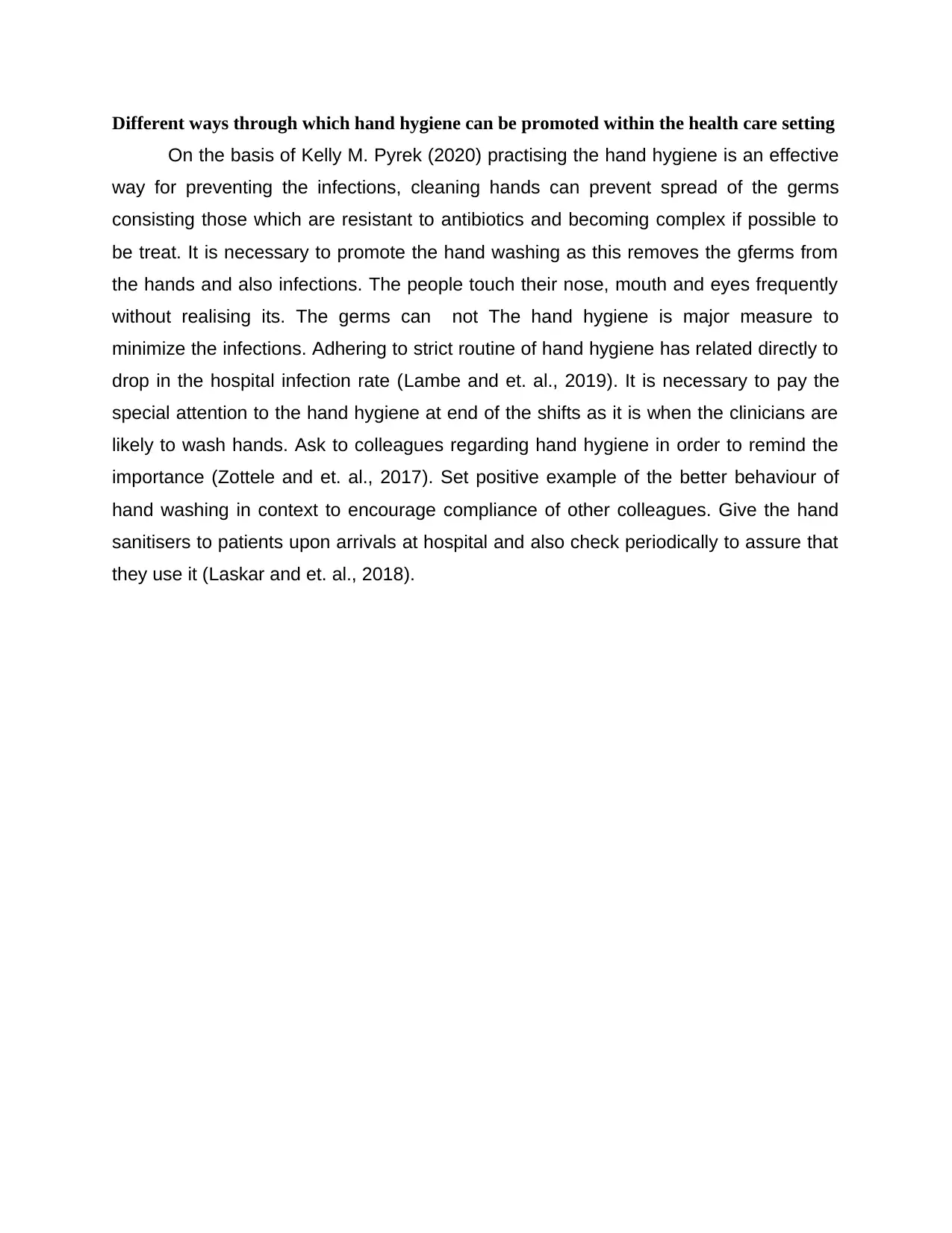
Different ways through which hand hygiene can be promoted within the health care setting
On the basis of Kelly M. Pyrek (2020) practising the hand hygiene is an effective
way for preventing the infections, cleaning hands can prevent spread of the germs
consisting those which are resistant to antibiotics and becoming complex if possible to
be treat. It is necessary to promote the hand washing as this removes the gferms from
the hands and also infections. The people touch their nose, mouth and eyes frequently
without realising its. The germs can not The hand hygiene is major measure to
minimize the infections. Adhering to strict routine of hand hygiene has related directly to
drop in the hospital infection rate (Lambe and et. al., 2019). It is necessary to pay the
special attention to the hand hygiene at end of the shifts as it is when the clinicians are
likely to wash hands. Ask to colleagues regarding hand hygiene in order to remind the
importance (Zottele and et. al., 2017). Set positive example of the better behaviour of
hand washing in context to encourage compliance of other colleagues. Give the hand
sanitisers to patients upon arrivals at hospital and also check periodically to assure that
they use it (Laskar and et. al., 2018).
On the basis of Kelly M. Pyrek (2020) practising the hand hygiene is an effective
way for preventing the infections, cleaning hands can prevent spread of the germs
consisting those which are resistant to antibiotics and becoming complex if possible to
be treat. It is necessary to promote the hand washing as this removes the gferms from
the hands and also infections. The people touch their nose, mouth and eyes frequently
without realising its. The germs can not The hand hygiene is major measure to
minimize the infections. Adhering to strict routine of hand hygiene has related directly to
drop in the hospital infection rate (Lambe and et. al., 2019). It is necessary to pay the
special attention to the hand hygiene at end of the shifts as it is when the clinicians are
likely to wash hands. Ask to colleagues regarding hand hygiene in order to remind the
importance (Zottele and et. al., 2017). Set positive example of the better behaviour of
hand washing in context to encourage compliance of other colleagues. Give the hand
sanitisers to patients upon arrivals at hospital and also check periodically to assure that
they use it (Laskar and et. al., 2018).
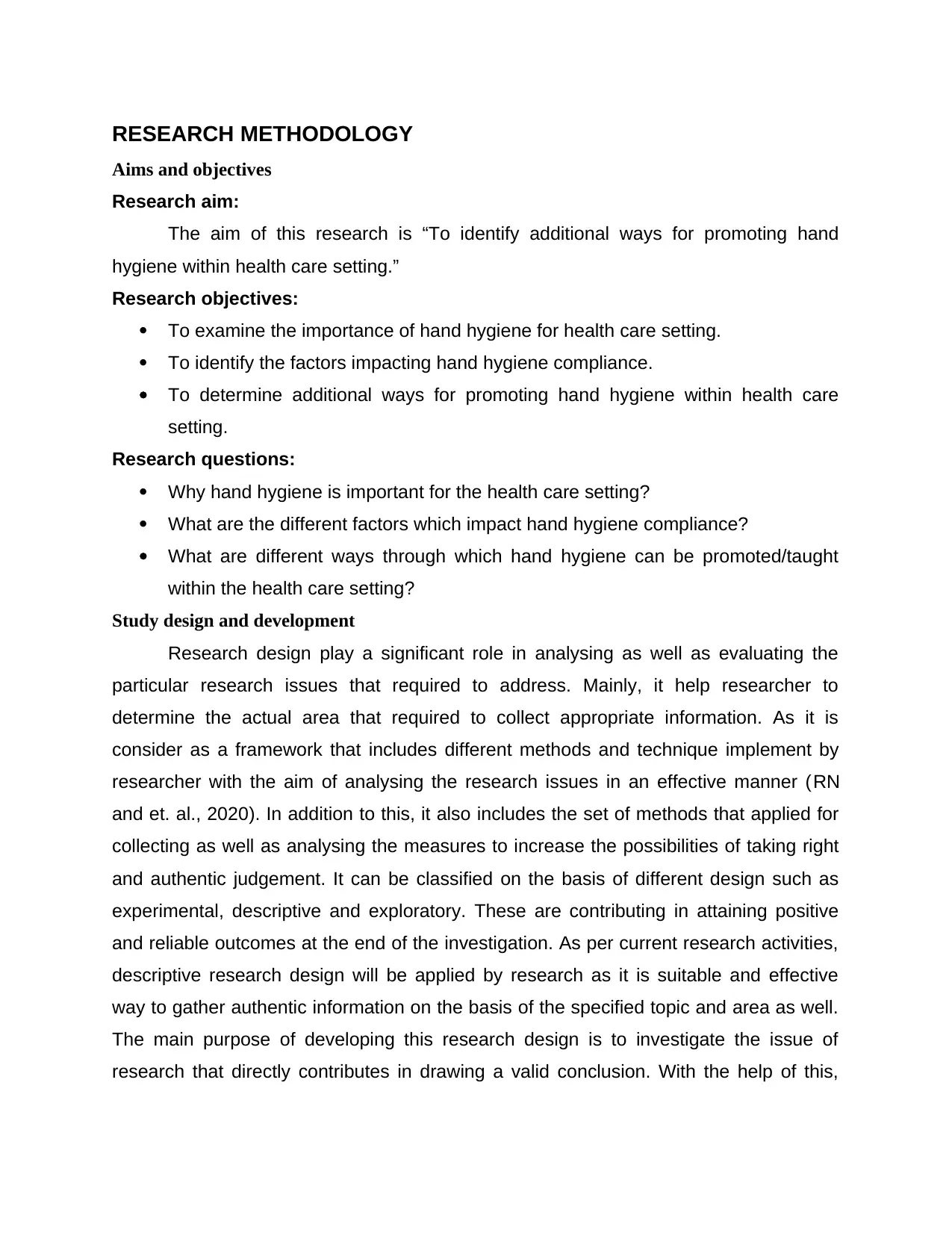
RESEARCH METHODOLOGY
Aims and objectives
Research aim:
The aim of this research is “To identify additional ways for promoting hand
hygiene within health care setting.”
Research objectives:
To examine the importance of hand hygiene for health care setting.
To identify the factors impacting hand hygiene compliance.
To determine additional ways for promoting hand hygiene within health care
setting.
Research questions:
Why hand hygiene is important for the health care setting?
What are the different factors which impact hand hygiene compliance?
What are different ways through which hand hygiene can be promoted/taught
within the health care setting?
Study design and development
Research design play a significant role in analysing as well as evaluating the
particular research issues that required to address. Mainly, it help researcher to
determine the actual area that required to collect appropriate information. As it is
consider as a framework that includes different methods and technique implement by
researcher with the aim of analysing the research issues in an effective manner (RN
and et. al., 2020). In addition to this, it also includes the set of methods that applied for
collecting as well as analysing the measures to increase the possibilities of taking right
and authentic judgement. It can be classified on the basis of different design such as
experimental, descriptive and exploratory. These are contributing in attaining positive
and reliable outcomes at the end of the investigation. As per current research activities,
descriptive research design will be applied by research as it is suitable and effective
way to gather authentic information on the basis of the specified topic and area as well.
The main purpose of developing this research design is to investigate the issue of
research that directly contributes in drawing a valid conclusion. With the help of this,
Aims and objectives
Research aim:
The aim of this research is “To identify additional ways for promoting hand
hygiene within health care setting.”
Research objectives:
To examine the importance of hand hygiene for health care setting.
To identify the factors impacting hand hygiene compliance.
To determine additional ways for promoting hand hygiene within health care
setting.
Research questions:
Why hand hygiene is important for the health care setting?
What are the different factors which impact hand hygiene compliance?
What are different ways through which hand hygiene can be promoted/taught
within the health care setting?
Study design and development
Research design play a significant role in analysing as well as evaluating the
particular research issues that required to address. Mainly, it help researcher to
determine the actual area that required to collect appropriate information. As it is
consider as a framework that includes different methods and technique implement by
researcher with the aim of analysing the research issues in an effective manner (RN
and et. al., 2020). In addition to this, it also includes the set of methods that applied for
collecting as well as analysing the measures to increase the possibilities of taking right
and authentic judgement. It can be classified on the basis of different design such as
experimental, descriptive and exploratory. These are contributing in attaining positive
and reliable outcomes at the end of the investigation. As per current research activities,
descriptive research design will be applied by research as it is suitable and effective
way to gather authentic information on the basis of the specified topic and area as well.
The main purpose of developing this research design is to investigate the issue of
research that directly contributes in drawing a valid conclusion. With the help of this,
⊘ This is a preview!⊘
Do you want full access?
Subscribe today to unlock all pages.

Trusted by 1+ million students worldwide
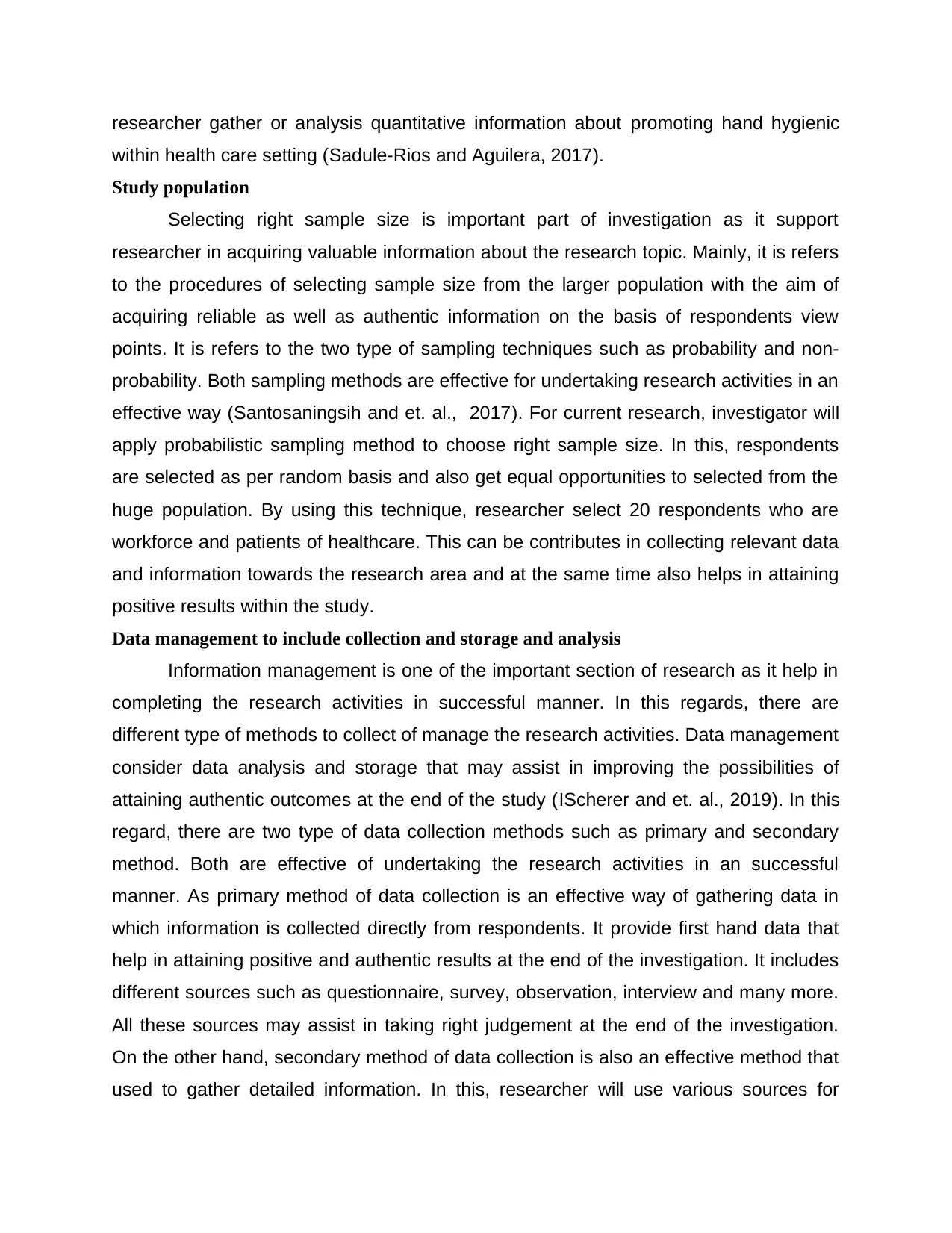
researcher gather or analysis quantitative information about promoting hand hygienic
within health care setting (Sadule-Rios and Aguilera, 2017).
Study population
Selecting right sample size is important part of investigation as it support
researcher in acquiring valuable information about the research topic. Mainly, it is refers
to the procedures of selecting sample size from the larger population with the aim of
acquiring reliable as well as authentic information on the basis of respondents view
points. It is refers to the two type of sampling techniques such as probability and non-
probability. Both sampling methods are effective for undertaking research activities in an
effective way (Santosaningsih and et. al., 2017). For current research, investigator will
apply probabilistic sampling method to choose right sample size. In this, respondents
are selected as per random basis and also get equal opportunities to selected from the
huge population. By using this technique, researcher select 20 respondents who are
workforce and patients of healthcare. This can be contributes in collecting relevant data
and information towards the research area and at the same time also helps in attaining
positive results within the study.
Data management to include collection and storage and analysis
Information management is one of the important section of research as it help in
completing the research activities in successful manner. In this regards, there are
different type of methods to collect of manage the research activities. Data management
consider data analysis and storage that may assist in improving the possibilities of
attaining authentic outcomes at the end of the study (IScherer and et. al., 2019). In this
regard, there are two type of data collection methods such as primary and secondary
method. Both are effective of undertaking the research activities in an successful
manner. As primary method of data collection is an effective way of gathering data in
which information is collected directly from respondents. It provide first hand data that
help in attaining positive and authentic results at the end of the investigation. It includes
different sources such as questionnaire, survey, observation, interview and many more.
All these sources may assist in taking right judgement at the end of the investigation.
On the other hand, secondary method of data collection is also an effective method that
used to gather detailed information. In this, researcher will use various sources for
within health care setting (Sadule-Rios and Aguilera, 2017).
Study population
Selecting right sample size is important part of investigation as it support
researcher in acquiring valuable information about the research topic. Mainly, it is refers
to the procedures of selecting sample size from the larger population with the aim of
acquiring reliable as well as authentic information on the basis of respondents view
points. It is refers to the two type of sampling techniques such as probability and non-
probability. Both sampling methods are effective for undertaking research activities in an
effective way (Santosaningsih and et. al., 2017). For current research, investigator will
apply probabilistic sampling method to choose right sample size. In this, respondents
are selected as per random basis and also get equal opportunities to selected from the
huge population. By using this technique, researcher select 20 respondents who are
workforce and patients of healthcare. This can be contributes in collecting relevant data
and information towards the research area and at the same time also helps in attaining
positive results within the study.
Data management to include collection and storage and analysis
Information management is one of the important section of research as it help in
completing the research activities in successful manner. In this regards, there are
different type of methods to collect of manage the research activities. Data management
consider data analysis and storage that may assist in improving the possibilities of
attaining authentic outcomes at the end of the study (IScherer and et. al., 2019). In this
regard, there are two type of data collection methods such as primary and secondary
method. Both are effective of undertaking the research activities in an successful
manner. As primary method of data collection is an effective way of gathering data in
which information is collected directly from respondents. It provide first hand data that
help in attaining positive and authentic results at the end of the investigation. It includes
different sources such as questionnaire, survey, observation, interview and many more.
All these sources may assist in taking right judgement at the end of the investigation.
On the other hand, secondary method of data collection is also an effective method that
used to gather detailed information. In this, researcher will use various sources for
Paraphrase This Document
Need a fresh take? Get an instant paraphrase of this document with our AI Paraphraser
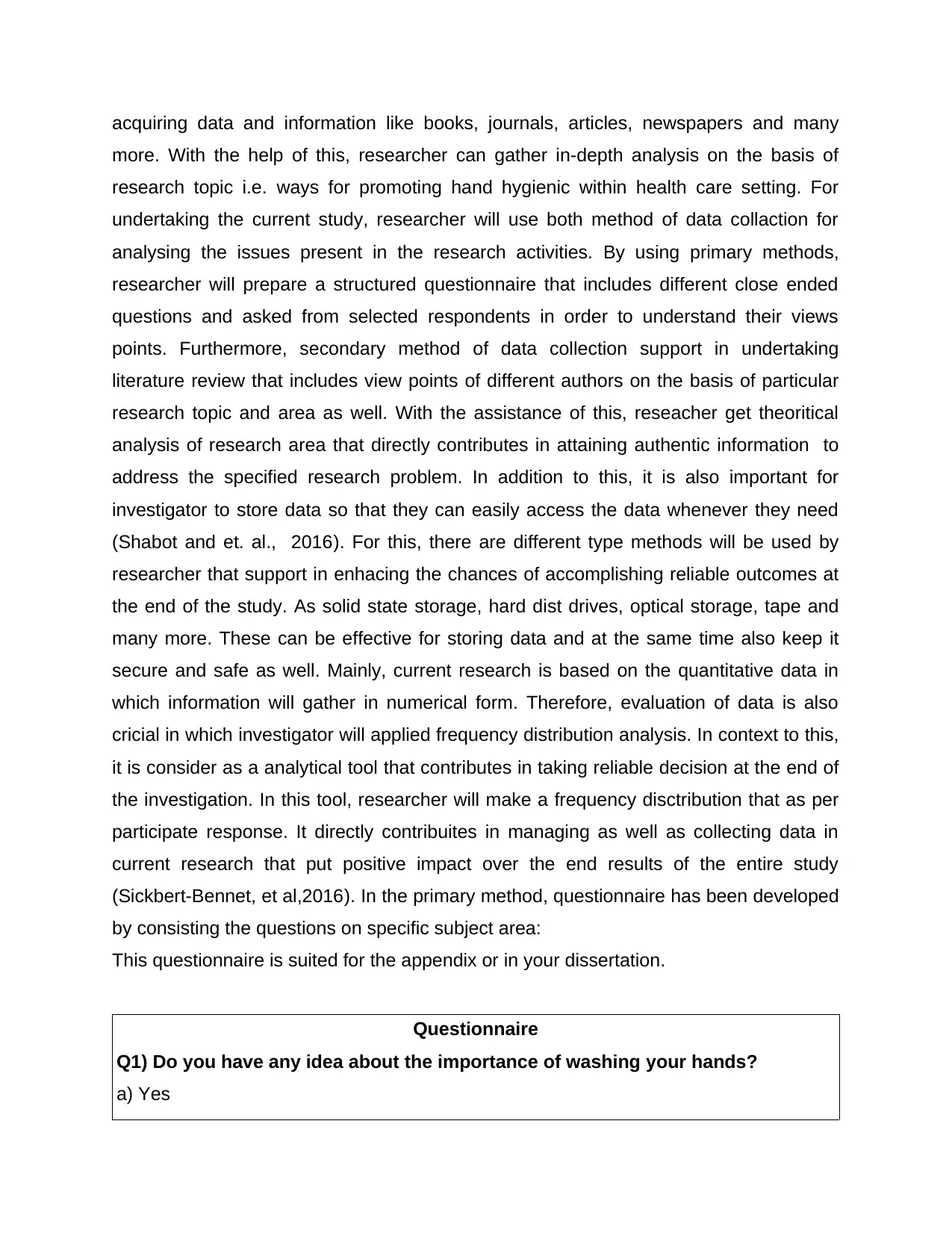
acquiring data and information like books, journals, articles, newspapers and many
more. With the help of this, researcher can gather in-depth analysis on the basis of
research topic i.e. ways for promoting hand hygienic within health care setting. For
undertaking the current study, researcher will use both method of data collaction for
analysing the issues present in the research activities. By using primary methods,
researcher will prepare a structured questionnaire that includes different close ended
questions and asked from selected respondents in order to understand their views
points. Furthermore, secondary method of data collection support in undertaking
literature review that includes view points of different authors on the basis of particular
research topic and area as well. With the assistance of this, reseacher get theoritical
analysis of research area that directly contributes in attaining authentic information to
address the specified research problem. In addition to this, it is also important for
investigator to store data so that they can easily access the data whenever they need
(Shabot and et. al., 2016). For this, there are different type methods will be used by
researcher that support in enhacing the chances of accomplishing reliable outcomes at
the end of the study. As solid state storage, hard dist drives, optical storage, tape and
many more. These can be effective for storing data and at the same time also keep it
secure and safe as well. Mainly, current research is based on the quantitative data in
which information will gather in numerical form. Therefore, evaluation of data is also
cricial in which investigator will applied frequency distribution analysis. In context to this,
it is consider as a analytical tool that contributes in taking reliable decision at the end of
the investigation. In this tool, researcher will make a frequency disctribution that as per
participate response. It directly contribuites in managing as well as collecting data in
current research that put positive impact over the end results of the entire study
(Sickbert-Bennet, et al,2016). In the primary method, questionnaire has been developed
by consisting the questions on specific subject area:
This questionnaire is suited for the appendix or in your dissertation.
Questionnaire
Q1) Do you have any idea about the importance of washing your hands?
a) Yes
more. With the help of this, researcher can gather in-depth analysis on the basis of
research topic i.e. ways for promoting hand hygienic within health care setting. For
undertaking the current study, researcher will use both method of data collaction for
analysing the issues present in the research activities. By using primary methods,
researcher will prepare a structured questionnaire that includes different close ended
questions and asked from selected respondents in order to understand their views
points. Furthermore, secondary method of data collection support in undertaking
literature review that includes view points of different authors on the basis of particular
research topic and area as well. With the assistance of this, reseacher get theoritical
analysis of research area that directly contributes in attaining authentic information to
address the specified research problem. In addition to this, it is also important for
investigator to store data so that they can easily access the data whenever they need
(Shabot and et. al., 2016). For this, there are different type methods will be used by
researcher that support in enhacing the chances of accomplishing reliable outcomes at
the end of the study. As solid state storage, hard dist drives, optical storage, tape and
many more. These can be effective for storing data and at the same time also keep it
secure and safe as well. Mainly, current research is based on the quantitative data in
which information will gather in numerical form. Therefore, evaluation of data is also
cricial in which investigator will applied frequency distribution analysis. In context to this,
it is consider as a analytical tool that contributes in taking reliable decision at the end of
the investigation. In this tool, researcher will make a frequency disctribution that as per
participate response. It directly contribuites in managing as well as collecting data in
current research that put positive impact over the end results of the entire study
(Sickbert-Bennet, et al,2016). In the primary method, questionnaire has been developed
by consisting the questions on specific subject area:
This questionnaire is suited for the appendix or in your dissertation.
Questionnaire
Q1) Do you have any idea about the importance of washing your hands?
a) Yes
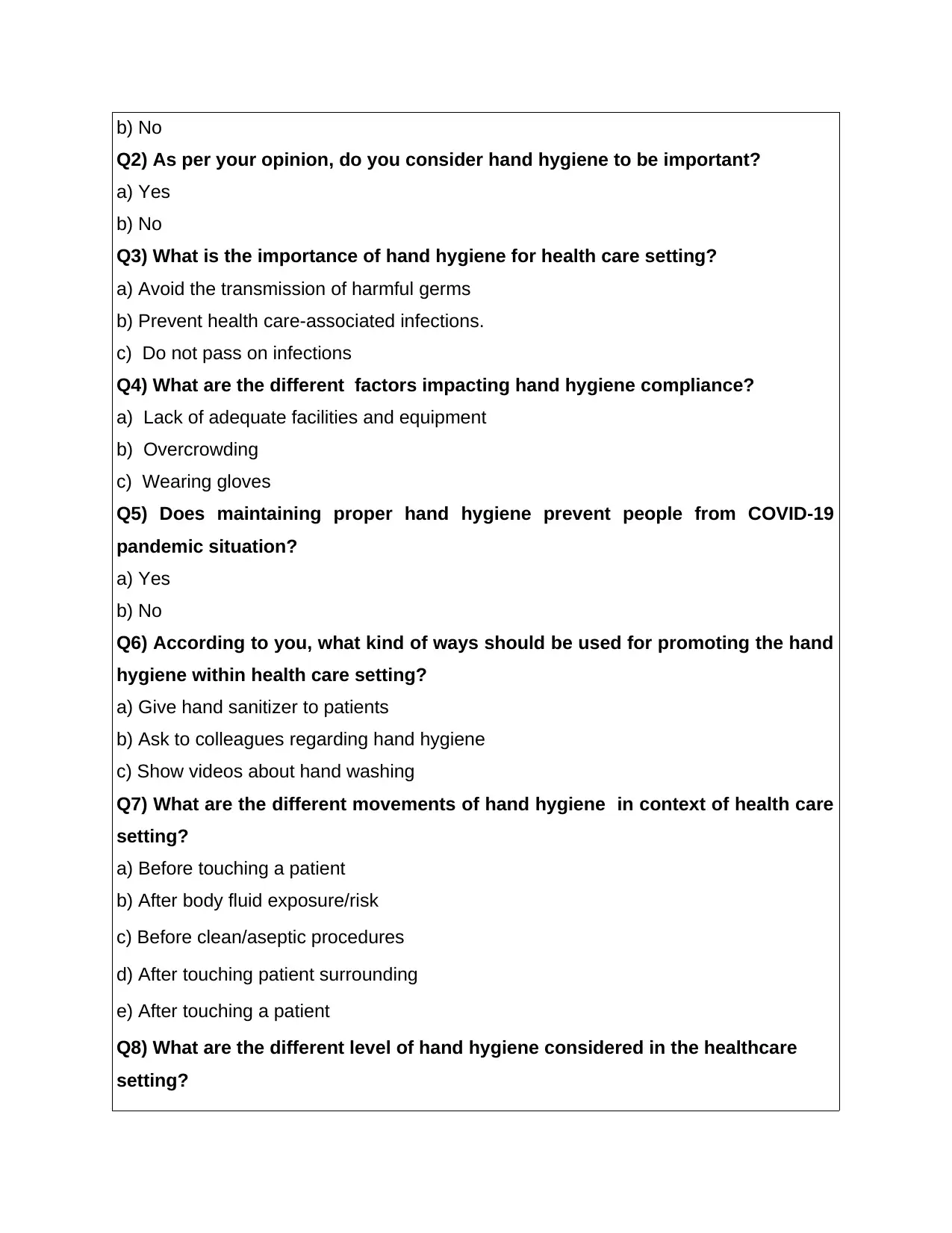
b) No
Q2) As per your opinion, do you consider hand hygiene to be important?
a) Yes
b) No
Q3) What is the importance of hand hygiene for health care setting?
a) Avoid the transmission of harmful germs
b) Prevent health care-associated infections.
c) Do not pass on infections
Q4) What are the different factors impacting hand hygiene compliance?
a) Lack of adequate facilities and equipment
b) Overcrowding
c) Wearing gloves
Q5) Does maintaining proper hand hygiene prevent people from COVID-19
pandemic situation?
a) Yes
b) No
Q6) According to you, what kind of ways should be used for promoting the hand
hygiene within health care setting?
a) Give hand sanitizer to patients
b) Ask to colleagues regarding hand hygiene
c) Show videos about hand washing
Q7) What are the different movements of hand hygiene in context of health care
setting?
a) Before touching a patient
b) After body fluid exposure/risk
c) Before clean/aseptic procedures
d) After touching patient surrounding
e) After touching a patient
Q8) What are the different level of hand hygiene considered in the healthcare
setting?
Q2) As per your opinion, do you consider hand hygiene to be important?
a) Yes
b) No
Q3) What is the importance of hand hygiene for health care setting?
a) Avoid the transmission of harmful germs
b) Prevent health care-associated infections.
c) Do not pass on infections
Q4) What are the different factors impacting hand hygiene compliance?
a) Lack of adequate facilities and equipment
b) Overcrowding
c) Wearing gloves
Q5) Does maintaining proper hand hygiene prevent people from COVID-19
pandemic situation?
a) Yes
b) No
Q6) According to you, what kind of ways should be used for promoting the hand
hygiene within health care setting?
a) Give hand sanitizer to patients
b) Ask to colleagues regarding hand hygiene
c) Show videos about hand washing
Q7) What are the different movements of hand hygiene in context of health care
setting?
a) Before touching a patient
b) After body fluid exposure/risk
c) Before clean/aseptic procedures
d) After touching patient surrounding
e) After touching a patient
Q8) What are the different level of hand hygiene considered in the healthcare
setting?
⊘ This is a preview!⊘
Do you want full access?
Subscribe today to unlock all pages.

Trusted by 1+ million students worldwide
1 out of 23
Related Documents
Your All-in-One AI-Powered Toolkit for Academic Success.
+13062052269
info@desklib.com
Available 24*7 on WhatsApp / Email
![[object Object]](/_next/static/media/star-bottom.7253800d.svg)
Unlock your academic potential
Copyright © 2020–2025 A2Z Services. All Rights Reserved. Developed and managed by ZUCOL.





